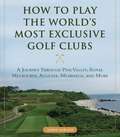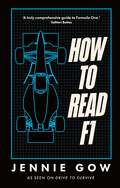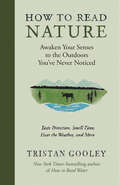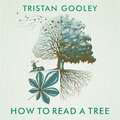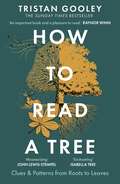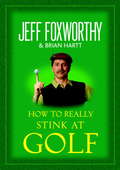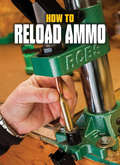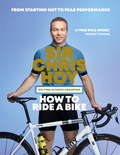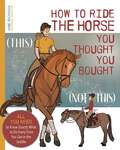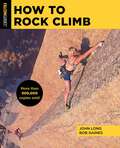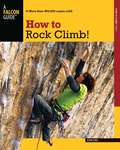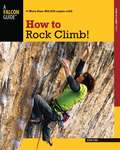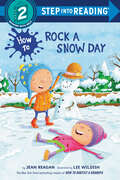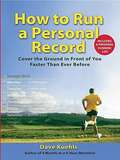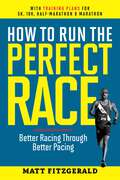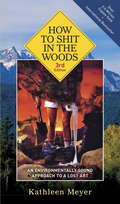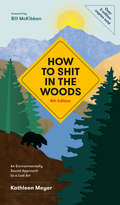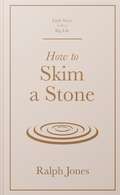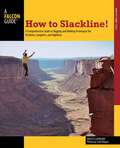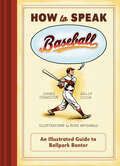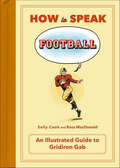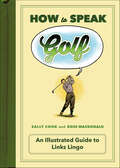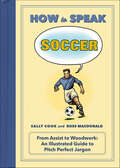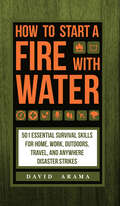- Table View
- List View
How to Play the World's Most Exclusive Golf Clubs: A Journey through Pine Valley, Royal Melbourne, Augusta, Muirfield, and More
by John SabinoThe most exclusive golf clubs in the world are special places that elicit feelings of awe and wonder from most golfers. How great would it be to play some of the storied venues of the game such as Winged Foot, Riviera or Muirfield? Or, the ultimate for any golfer, Augusta National, home of the Masters? How to Play the World’s Most Exclusive Golf Clubs highlights the many ways that golfers can enter the world’s elite clubs, located in some of the most beautiful locations in the world. How do you go about gaining access to some of some of golf’s hallowed grounds? Who do you have to know? How do you find a member? What is the etiquette to follow? This book gives insights into what has worked for the author and other motivated golfers.An avid golfer and student of golf history, John brings an unparalleled enthusiasm, a unique perspective, and an insider’s insights to the task. Throughout each chapter there are personal stories about the author’s experience and unique stories about some of the lengths to which golfers have gone to gain access to golf’s premier venues. The proliferation of golf course ratings by magazines, combined with the expanded information about golf courses and golf architecture that the Internet age has brought to the fore, has created a new and expanding group of golf aficionados who dream of playing at exclusive golf courses and are eager to learn the secrets of doing so. This book’s coverage of more than 125 global clubs will be perfect for any player.Skyhorse Publishing, as well as our Sports Publishing imprint, is proud to publish a broad range of books for readers interested in sports-books about baseball, pro football, college football, pro and college basketball, hockey, or soccer, we have a book about your sport or your team.In addition to books on popular team sports, we also publish books for a wide variety of athletes and sports enthusiasts, including books on running, cycling, horseback riding, swimming, tennis, martial arts, golf, camping, hiking, aviation, boating, and so much more. While not every title we publish becomes a New York Times bestseller or a national bestseller, we are committed to publishing books on subjects that are sometimes overlooked by other publishers and to authors whose work might not otherwise find a home.
How to Read F1: Everything you need to know about racing in the fast lane
by Jennie Gow'Formula 1 is as complex as it is competitive, existing in a world which has built up a language almost unique to itself. Jennie has been working the Formula 1 pitlanes and paddocks of the world since before many of today’s superstars had even started karting. She knows the sport inside out. There’s nobody better to take you on this alphabetic adventure through the greatest sport in the world.' Will Buxton'This is a great read for old and new fans of F1, one that will inform, educate and entertain you. A truly comprehensive guide to Formula One - from A to Z (and most importantly, to B).' Valtteri Bottas'Jennie's job is to go where angels fear to tread. Being in the pit lane and on the grid or even in the F1 paddock is not for the faint of heart. It takes courage and a lot of hard work to know your stuff and ask the difficult questions in F1. Jennie Gow is that gal!' – Damon Hill'Jennie brings such a great passion to broadcasting on F1.' – Nico RosbergFun, informative and insightful, How to Read F1 is the perfect gift for Formula One fans.BBC F1 presenter and Drive to Survive expert Jennie Gow covers the key concepts, drivers, teams, tech and rules in an easy-to-read, bitesize format. Featuring bespoke illustrations capturing the sport's famous faces and technical elements, the book is packed with Jennie's unique insights, anecdotes and plenty of trivia. Whether you’re new F1 and keen to learn more or a veteran supporter looking to brush up on facts, there’s something for everyone in this entertaining guide to racing in the fast lane.
How to Read Nature: Awaken Your Senses to the Outdoors You've Never Noticed (Natural Navigation #0)
by Tristan GooleyHone your senses and learn to read the hidden signs of nature—from master outdoorsman Tristan Gooley, New York Times–bestselling author of How to Read a Tree and The Lost Art of Reading Nature’s Signs "Equal parts alfresco inspiration, interesting factoids, how-to instructions and self-help advice."—The Wall Street Journal When most of us go for a walk, a single sense—sight—tends to dominate our experience. But when New York Times–bestselling author and expert navigator Tristan Gooley goes for a walk, he uses all five senses to "read" everything nature has to offer. A single lowly weed can serve as his compass, calendar, clock, and even pharmacist. In How to Read Nature, Gooley introduces readers to his world—where the sky, sea, and land teem with marvels. Plus, he shares 15 exercises to sharpen all of your senses. Soon you’ll be making your own discoveries, every time you step outside!
How to Read a Tree: The Sunday Times Bestseller
by Tristan GooleyDo two trees ever appear identical? No, but why? Every small difference is a clue.Each tree we meet is filled with signs that reveal secrets about the life of that tree and the landscape we stand in. The clues are easy to spot when you know what to look for, but remain invisible to most people.In How to Read a Tree, you'll discover the simple principles that explain the shapes and patterns you can see in trees and what they mean. And you'll learn rare skills that can be applied every time you pass a tree, whether you are in a town or a wilder spot.As the author of the international bestsellers The Walker's Guide and How to Read Water, Tristan Gooley knows how to uncover the phenomena worth looking for. He has been instructing people in the art of reading trees for two decades and this book includes signs that will not be found in any other book in the world.Once you have learned to see these things it is impossible to unsee them. We will never look at a tree the same way again.(P) 2023 Hodder & Stoughton Limited
How to Read a Tree: The Sunday Times Bestseller
by Tristan Gooley'An important book and a pleasure to read.' - Raynor Winn, author of The Salt Path'You will never look at a tree in the same way again after reading this mesmerising book. Gooley drops learning as lightly as blossom falls in spring.' - John Lewis-Stempel'Tristan Gooley has done trees the greatest service.' - Isabella Tree'It was a lightbulb moment! I thought I knew my local woods - I walk there almost every day. But it's a thrill to see it through fresh eyes, to develop a much deeper understanding.' - Peter Gibbs, Chair of BBC Gardeners' Question Time'Wherever you are - city or wilderness - if you want to understand the secrets of trees you pass, this is the book to read...Tristan has the rare gift of explaining the most complex ideas with humour and deep insight.' - Peter Thomas, Emeritus Reader in Plant Ecology at Keele University, author of Trees'Will undoubtedly leave you with a deeper appreciation of trees...your country walks will never be quite the same again' - Daily Mail'This book will add a new dimension to your countryside stroll.' WanderlustDo two trees ever appear identical? No, but why? Every small difference is a clue.Each tree we meet is filled with signs that reveal secrets about the life of that tree and the landscape we stand in. The clues are easy to spot when you know what to look for, but remain invisible to most people.In How to Read a Tree, you'll discover the simple principles that explain the shapes and patterns you can see in trees and what they mean. And you'll learn rare skills that can be applied every time you pass a tree, whether you are in a town or a wilder spot.As the author of the international bestsellers The Walker's Guide and How to Read Water, Tristan Gooley knows how to uncover the phenomena worth looking for. He has been instructing people in the art of reading trees for two decades and this book includes signs that will not be found in any other book in the world.Once you have learned to see these things it is impossible to unsee them. We will never look at a tree the same way again.
How to Really Stink at Golf
by Jeff Foxworthy Brian HarttAs a longtime golfer, Jeff Foxworthy has learned something important about the grand auld game: It’s not who has the highest score, it’s who has the least fun playing it. And now, in his hilarious primer How to Really Stink at Golf, Foxworthy shares his invaluable tips for a lifetime of horrible drives and putts. • Get into the right frame of mind to play truly awful golf. Food poisoning or a killer hangover might be just the ticket to a robust three-digit score. • Try to get to the course promptly at tee time to avoid the hassle of warming up: “You’re only gonna hit five good shots in the course of the day; why waste even one on the driving range?” • The surefire way to screw up a great drive? As you walk to the tee, keep telling yourself, “Don’t screw up your drive. ” If bad golf’s your goal, stress is your best friend. • Avoid fun. “Fun = relaxed = low scores . . . and that’s something we want to avoid at all cost. If you have a good hole, shake it off. ” • Perhaps the most important element: Embrace the fact that you do stink at golf. Cheating. Cursing. Avoiding fairways. Reckless cart driving. How to Really Stink at Golf covers it all, from selecting the correct putter to use on a 385-yard drive to prolonging your stay in the sand trap to picking the perfect foursome for spectacularly bad golf (“you, your ex-wife, your girlfriend, your wife”). With Jeff Foxworthy as your guide, even a scratch golfer can add ten, twenty, maybe thirty strokes to his or her score–and possibly more if you attempt to play the back nine, too. From the Hardcover edition.
How to Reload Ammo
by Phil MassaroExcerpt from Chapter 1:As a reloader, the first and foremost piece of gear you'll need is a reloading press. They come in many different shapes, sizes, colors, and styles, and your style of reloading should dictate which one will best serve your needs. Are you a high volume reloader? Do you primarily reload for pistols or rifles? Or maybe both? Let's take a look at the different options and get you set up properly.
How to Ride a Bike: From Starting Out to Peak Performance
by Sir Chris Hoy'Chris is someone I've always looked up to. A true role model.' - Geraint Thomas, 2018 Tour de France winnerAn invaluable manual for cyclists of all ages, experience and ability, which will help them achieve peak performance.Full of practical advice, this book includes information on: Strength conditioning to improve your performance Targeted training plans to focus on strengthening weaker areas Bike care & maintenance Riding different terrains & environments Road cycling skills & safety The book will also help you explore your five key abilities of cycling fitness, defined as the maximum effort you can maintain for the following periods of time: 6 seconds (max sprinting) 30-60 seconds (sub-max sprinting) 3-5 minutes (VO2 max) 1 hour (zone of transition) Several hours (long steady distance riding) This book is training toolbox to structure bespoke sessions to improve these five facets of performance. How to Ride a Bike also features diet and weight loss advice, the psychology of cycling, and stories and anecdotes from Sir Chris Hoy's Olympic track career.Full of helpful and inspiring advice for those getting on a bike for the first time in a while, along with plenty of tips and tricks for seasoned cyclists looking to take it up a notch, this is a book for beginners and pros alike.
How to Ride a Bike: From Starting Out to Peak Performance
by Sir Chris HoyAn invaluable manual for cyclists of all ages, experience and ability, which will help them achieve peak performance. Full of practical advice, this book includes information on: Strength conditioning to improve your performance Targeted training plans to focus on strengthening weaker areas Bike care and maintenance Riding different terrains and environments Road cycling skills and safety The book will also help you explore your five key abilities of cycling fitness, defined as the maximum effort you can maintain for the following periods of time: 6 seconds (max sprinting) 30-60 seconds (sub-max sprinting) 3-5 minutes (VO2 max) 1 hour (zone of transition) Several hours (long steady distance riding) This book acts as a training toolbox with which you can structure bespoke sessions to improve these five facets of performance. There's also advice on diet, weight loss and the psychology of cycling, and plenty of stories and anecdotes from Sir Chris Hoy's Olympic track career.Full of helpful and inspiring advice for those getting on a bike for the first time in a while, along with plenty of tips and tricks for seasoned cyclists looking to take it up a notch, this is a book for beginners and pros alike.
How to Ride the Horse You Thought You Bought
by Anne BuchananA go-to reference and a launchpoint for every amateur hoping to grow her horsemanship abilities while doing right by her horse.In this fresh look at the fundamental skills needed when training and riding a horse, career educator and lifelong horsewoman Anne Buchanan provides crucial keys so the everyday horse enthusiast can:Decode how the horse functions.Become aware of crucial technicalities of riding that are often overlooked or bypassed.Grow a toolbox of training ideas so that every ride has meaningful and attainable goals.Easily recall what to do, when, during any ride.With the understanding that many riders yearn to beproductivewith their horses, Buchanan empowers them with well-researched and time-tested answers to the question, &“What should I do with my horse today?&” She also addresses the building blocks that must be in place so that this question can be answered in many ways, and all of them successful. These include:The &“Ground Rules&”—essential groundwork and communication skills.The six &“Nonnegotiables&” for good riding—Go, Get Connected, Stay Connected, Transitions, Flexion, and Half-Halt.Guidelines for learning on your own—how to carry on and grow your knowledge and skillset, independently when necessary.In addition, &“Study Guides&” throughout the book serve as easy-to-use &“formulas&” so readers can reconstruct what they've learned at any time. Buchanan employs mental tools the human brain uses to make sense of information to help readers engage with the material and:Familiarize them with the terminology, concepts, and skills needed for riding.Develop the confidence necessary to implement these concepts and skills when working with their horses.Help develop day-to-day and long-range plans to reach training and riding goals.Buchanan endeavors to translate the experience of riding into words so that readers can think like good riders think, feel what good riders feel, and do what good riders do. The result is the ability to recognize what is working, what isn't, what you need to do, and whether you achieve it—even when you are riding and training on your own. With engaging illustrations and links to helpful instructional videos throughout, this is both a go-to reference and a launchpoint for every amateur hoping to grow her horsemanship abilities while doing right by her horse.
How to Rock Climb (How To Climb Series)
by John Long Bob GainesHow to Rock Climb, now in its sixth edition, is the most thorough instructional rock book in the world. All the fundamentals—from style and ethics, to physically scaling the rock—are presented by climbing experts John Long and Bob Gaines. Completely revised and updated to reflect state-of-the-art methods, this book includes sections on face climbing, crack climbing, equipment, anchoring, belaying, toproping, leading, rappelling, sport climbing, trad climbing, multipitch climbing and much more. How to Rock Climb is the essential how-to book for rock climbers everywhere.
How to Rock Climb! (How To Climb Series)
by John LongHow to Rock Climb!, now in its fifth edition, is the most thorough instructional rock climbing book in the world. All the fundamentals—from ethics to getting up the rock—are presented in John Long's classic style. Thoroughly revised and updated to reflect the modern standards of equipment, technique, and training methods, this guide includes sections on face climbing; crack climbing; ropes, anchors, and belays; getting off the rock; sport climbing; and much more. It is the essential how-to book for rock climbers everywhere.Now with more than 300 color photographs and illustrations, this is the most thorough and complete upgrade this best-selling title has seen since first publishing more than a decade ago.
How to Rock Climb, (How to Climb Series)
by John LongThoroughly revised and updated to reflect the modern standards of equipment, technique, and training methods, this guide includes sections on face climbing; crack climbing; ropes, anchors, and belays; getting off the rock; sport climbing; and much more. It is the essential how-to book for rock climbers everywhere.
How to Rock a Snow Day (Step into Reading)
by Jean ReaganA snow day! That means no school...But what will we do today? From the New York Times bestselling creators of How to Babysit a Grandpa comes a seasonal Step 2 early reader packed with snow much fun!School is canceled, and there is so much to do: snow angels, lunch, sledding... Will the other kids be able to finish everything on our snow day to-do list?! Join them as they enjoy a snow-filled day of winter activities! Perfect for children who are ready to read on their own. Step 2 readers use basic vocabulary and short sentences to tell simple stories. They are perfect for children who recognize familiar words and can sound out new words with help.
How to Run a Personal Record
by Dave KuehlsTraining tips for record-breaking distance running from the author of 4 Months to a 4-Hour Marathon. The only running book targeted specifically to help runners set a personal record, this indispensable guide offers specific training programs for each of the four most popular race distances: 5K, 10K, half-marathon, and marathon. It also includes a common-sense discussion of the training process (a time-tested, three-pronged approach), information on everything runners need to know from day one to crossing the finish line, plus race-day strategies to squeeze out precious minutes and seconds from that finish line clock. How to Run a Personal Record features a 32-page training log where the reader can log their progress through the 16-week training phase. .
How to Run the Perfect Race: Better Racing Through Better Pacing
by Matt FitzgeraldBestselling author and coach Matt Fitzgerald explains how to train for and execute a perfect race. Master the art of pacing and run your next 5K, 10K, half-marathon, or marathon at your real limit. Every runner knows pacing is critical. It can be the difference between a breakthrough workout and a backbreaker, between a PR and a DNF. In How to Run the Perfect Race, acclaimed running coach Matt Fitzgerald reveals how conventional training and device overdependence keep runners from accessing the full power of pacing. With a mix of fascinating science and compelling stories from every corner of the sport, Fitzgerald demonstrates that pacing is the art of finding your real limit—running at a pace to finish the workout or cross the finish line completely out of gas. This quintessential running skill unlocks hidden potential and transforms the sport, enabling runners of all experience and ability levels to continually improve their race execution. Training plans for 5K, 10K, half-marathon, and marathon events will hone your pacing skill through improved body awareness, judgment, and toughness. Choose from four plans, novice to expert, for each race distance. How to Run the Perfect Race equips you mentally and physically to become a better runner, capable of knowing and executing your best effort on any given day.
How to Shit in the Woods, 3rd Edition
by Kathleen MeyerWHEN NATURE CALLS. . . After rowing hundreds of urban North Americans down whitewater rivers, Kathleen Meyer discovered that defecating in the wild without a commode is hardly an innate skill, but a complex procedure desperately in need of a protocol! This sobering revelation, and her subsequent mastery of the artform, has made How to Shit in the Woods the backcountry bible of eco-friendly outdoor elimination options since 1989. Long-embraced by the outdoor community, How to Shit in the Woods is still the go-to primer for backpackers and hikers, campers and climbers, skiers, sea kayakers, river runners, and all off-the-grid sojourners. The third edition presents the latest innovations, high-tech to low-tech, for responsible human waste disposal. Also featured: reflections on the increasing adoption of "packing-it-out," a practice designed to help protect sensitive environments; the most current safeguards against health risks associated with drinking straight from wilderness waterways; suggestions for purists who plan to leave the t.p. at home; and a wealth of recommendations for ladies who must make do without a loo. Meyer's delightfully shameless discussion of a once-shameful activity, her erudite examination of its associated vocabulary, and her unapologetic promotion of its colorful vernacular, make How to Shit in the Woods essential--and vastly entertaining--reading for anyone who has ever paused at the edge of the wilderness and pondered, "Where do I go to go?"From the Trade Paperback edition.
How to Shit in the Woods, 4th Edition: An Environmentally Sound Approach to a Lost Art
by Kathleen MeyerThe definitive guide to eco-friendly outdoor defecation--fully revised with a new introduction by renowned author and environmental activist Bill McKibben.More than thirty years since its first publication, Kathleen Meyer delivers an update to the beloved guide to relieving yourself responsibly. Meyer's delightfully shameless discussion of a once-secretive activity examines the environmental impact of too much crap (organic and otherwise) on our ever-shrinking wild outdoors. With the rising popularity of hiking and off-the-grid backpacking as well as the current climate crisis, How to Shit in the Woods provides timely techniques for keeping trails, bushes, and wild waters clean and protected when indoor plumbing is not an option. Meyer shares proper procedures in a way that is approachable and comprehensible for all audiences, from beginner to expert. The fourth edition features updates to outdoor laws and regulations, health statistics, and recommendations for equipment such as special trowels, funnels, and portable toilets. With more than three million copies sold, How to Shit in the Woods is the backcountry backpacker's bible, crucial for anyone looking to be wiser with their waste.
How to Skim a Stone (Little Ways to Live a Big Life #6)
by Ralph Jones'A modest masterpiece and a complete delight' - Derren BrownThis is the ultimate guide to skimming a stone.Stone skimming is an art and a science: a brief distraction on a country walk and an international sport with highly competitive championships.Ralph Jones covered last year's World Stone Skimming Championships and here, he investigates the physics, the strategy and the philosophy behind the urge we all experience when we come across a body of water and some nice flat stones. In this beautiful little book, you'll learn how to select the perfect stone, add just the right amount of spin, calculate the angle and measure the ideal distance to the first bounce on the water. Whether you're a rookie beginner or a seasoned pro, or somewhere in between, this delightful book will have you making ripples in no time.
How to Slackline!: A Comprehensive Guide to Rigging and Walking Techniques for Tricklines, Longlines, and Highlines (How To Climb Series)
by Hayley AshburnOriginating in the climbing world, slacklining is the act of balancing along a narrow, flexible piece of webbing that has been anchored between two stable objects. How to Slackline! covers the short history of slacklining and the sport&’s rapid growth since the advent of the Gibbon Trickline, which brought slacklining to enthusiasts outside the climbing community. The book includes detailed methods for building tricklines (low lines used for jumping tricks), longlines (low lines where the goal is to walk as long as possible), and highlines (slacklines rigged high between cliffs using climbing gear). Technique chapters cover the skills needed to practice all types of slacklining. How To Slackline! is the definitive resource on the emerging sport of slacklining, written by Hayley Ashburn, a top expert in the field, and accompanied by Scott Rogers' stunning color photography.
How to Speak Baseball: An Illustrated Guide to Ballpark Banter
by Sally Cook James Charlton“An elegantly designed little book . . . capturing the colorful, frequently fanciful vocabulary that describes the world of baseball.” —The Litchfield County TimesThis handsome guide to the language of baseball decodes the amusing, clever phrases that pepper commentary about the sport. Packed with witty explanations of everything from “duster” and “rubber arm” to “up the elevator,” this ballpark lexicon plays on a nostalgic love for the national pastime while covering ground from baseball’s beginnings to today. This humorous mix of definitions and anecdotes is the perfect gift for both lifelong baseball fans and rookies “working up the ranks.”“If you happen to be watching or listening to a game, do you wonder what the announcer means by ‘the neighborhood play,’ ‘can of corn’ or ‘golden sombrero?’ How to Speak Baseball: An Illustrated Guide to Ballpark Banter, by James Charlton and Sally Cook, is an informative, entertaining read. The authors have compiled a list of obscure, old and newer baseball terms from ‘ace’ to ‘you can’t walk off the island.’” —Daily Pilot
How to Speak Football: An Illustrated Guide to Gridiron Gab
by Sally Cook Ross MacDonaldFrom "ankle breaker” to “zebra,” How to Speak Football includes over 125 football terms paired with amusing illustrations that decode the words and phrases that fly around the field.The “Sidelines” sections sprinkled throughout the book will teach you fun trivia about the history of the sport, the stories behind football players’ nicknames, the most famous touchdown celebrations, and much more! The terms included in the book range from the well-known, like “blitz” and “punt,” to the more uncommon such as:-Alligator arms: A term coaches, players, and television commentators frequently use to describe—and disparage—a receiver who keeps his arms protectively tucked in close to his ribs, instead of stretched out to catch the ball. -Chain gang: The officials on the sideline who hold the yardage and down markers.-Pancake: A forceful block, usually by an offensive lineman, tight end, or fullback, that sets an opposing lineman completely on his back, taking him out of play.A fantastic blend of funny anecdotes and entertaining bits of history and trivia, Sally Cook and Ross MacDonald's book is the perfect gift for all the football lovers in your life, fantasy fanatics, or any of the growing number of fans who are gravitating toward this exciting sport!
How to Speak Golf: An Illustrated Guide to Links Lingo (How To Speak Sports Ser.)
by Sally Cook Ross MacDonaldFrom ace to zinger, How to Speak Golf includes over 125 golf terms paired with charming and clever illustrations that decode the words and phrases that fly around a golf course.Clubhouse Chatter sections are sprinkled throughout where you'll learn about everything from the origins of golf, the worst courses and biggest sand bunkers in the world, to the reason why there are so many bird references in golf terminology, a history of famous holes-in-one, and much, much more! Some of the terms included in the book are:-Army golf: The inconsistent hitting of the ball from one side of the fairway to the other. (Think: Left, right, left.)-Cabbage: The worst of the rough. (Also known as "Spinach" or "Lettuce." Whatever you call it, this is a salad to be avoided.)-Ham and egg: When two players on a team pair well, with one player excelling whenever the other falters.-Velcro: Greens that are slow, where it seems like the ball sticks to the grass.Author Sally Cook and illustrator Ross MacDonald offer the perfect blend of funny anecdotes and fascinating bits of history and trivia. This is the perfect gift book to have you talking like a master whether you're a pro, a lifelong fan, or a novice on the greens.
How to Speak Soccer: From Assist to Woodwork: An Illustrated Guide to Pitch Perfect Jargon (How to Speak Sports)
by Sally Cook Ross MacDonaldHow to Speak Soccer covers all of the terms and definitions that fly around the field and includes fascinating bits of trivia.Soccer, the world's most popular sport, has a growing fan base with millions of enthusiasts. Whether you're a newcomer to this exciting sport or a longtime fan, in How to Speak Soccer authors Sally Cook and Ross MacDonald share the definitions to over 150 terms, plus a range of amusing trivia. Learn about the history of the World Cup, where red and yellow cards come from, and much more!-Diving Header: When a player dives horizontally to head a ball at knee-height-Rainbow Kick: A trick kick that is done by flicking the ball with the back of the heel and over one's head. It is usually employed to avoid a sliding tackle.-Rocket: A shot that is struck with immense power.
How to Start a Fire with Water: 501 Essential Survival Skills for Home, Work, Outdoors, Travel, and Anywhere Disaster Strikes
by David AramaLife is unpredictable—are you prepared for it?Should disaster ever strike, you'll feel prepared with this book as your guide. Inside you'll find tips and tricks for surviving unpredictable situations at home, work, outdoors, and while traveling. From natural catastrophes such as lightning strikes, wildfire, floods, earthquakes, and tornadoes to man-made dangers such as car accidents, plane crashes, and electrical fires, this book will help you take the first steps to survival—being prepared.
